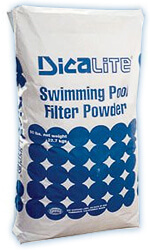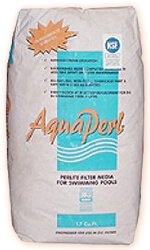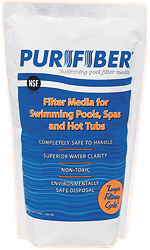FREE Standard Shipping On All Orders $100 or More!*
Diatomaceous Earth, Perlite & Cellulose
Today's lecture will focus on 3 types of filter media powder available for Diatomaceous Earth pool filters. D.E. filters have a set of fabric coated grids (aka elements or septums), which are arranged and spaced apart inside the filter tank. DE filter grids don't actually filter the water; the powder is the filter media, coating the grids to trap dirt as the water passes into the grids and out of the filter.
Diatomaceous Earth, Perlite and Cellulose are 3 types of natural filter media, or filter powder that can be used in DE pool filters.
DIATOMACEOUS EARTH

DE powder is composed of the ancient skeletal remains of Diatoms, which are harvested from the ocean floor, and separated into clean, white powder.
The major component of Diatomaceous Earth powder is silicon dioxide, a mix of amorphous and crystalline silicone, or glass.
Crystalline silicone dioxide has been linked to health problems for users. D.E. also doesn't break down and rinse away as easily as alternative filter medias, which can be harmful to sensitive local ecosystems.
At a cost of less than $1 per pound, D.E. powder is the number one choice for DE filter media, and filters water effectively down to 3-5 microns.
PERLITE

Perlite is another natural product, produced by heating volcanic rock to extremely high temperatures, at which point it explodes like popcorn.
These Perlite kernals, containing hundreds of tiny air pockets are then ground down into a very lightweight powder, for use in DE pool filters. Perlite is so lightweight, that only half the amount of DE powder is needed.
Proponents of Perlite say that the light weight results in less bridging between grids, more complete backwashes and longer filter cycles, as compared to DE powder.
At $2 per pound, Perlite is twice the cost of DE powder, but half the weight - meaning that you only need to use half as much for the same filtration ability of 3-5 microns.
CELLULOSE

Plant based fibers, wood pulp usually, are the main components of Cellulose Fiber filter media. Natural, biodegradable, renewable and non-toxic.
Cellulose fiber also makes a good filter aid for sand and cartridge filters, increasing their filtration ability and protecting filter cartridges.
Cellulose may clog-up sooner than DE, being that it can also trap oils and grease, unlike DE powder, and other particles as small as 2 microns.
Cellulose fibers are so effective, they can even clog-up from the use of polymer chemicals, such as algaecides, clarifiers, phosphate removers or metal removers, which are not recommended for use with fiber media.
At $5 per pound, PuriFiber is the most costly of DE filter alternative media - but it goes much further, only 6 oz is needed for each 10 Sq Ft of filter area.
If you have a DE pool filter, and are concerned with possible health or environmental risks of using DE filter powder, consider using an alternative filter media such as Perlite or Cellulose in your tank.